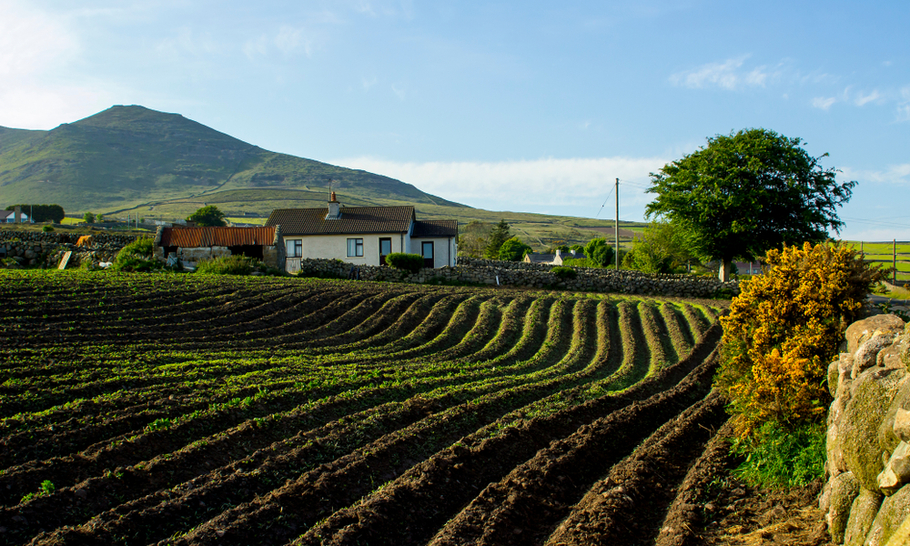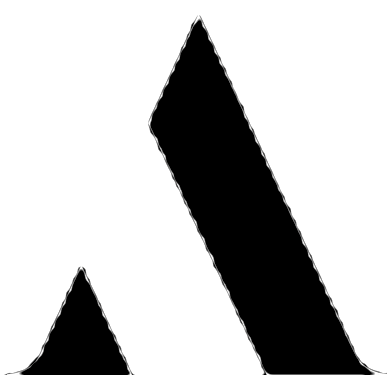Borders in the mind – the enduring question of identity

“…we have rights drawn from the soil and sky; the use, the pace, the patient years of labour”. A ploughed field on the foothills of the Mourne Moun...
Growing up a Catholic in Northern Ireland, I had no doubt that I was Irish. I have an Irish name. An early memory is learning to write my full name in the Irish language. At my Catholic primary school I learned Irish, ceilidh dancing and the Irish national anthem. I recited poems in Irish at ‘Feiseanna’ in predominantly Catholic towns. But I also recited poems in English and danced ballet at ‘Festivals’ in predominantly Protestant towns.
At my convent boarding school, thanks to the Northern Ireland examination syllabus, my education was largely English. Ireland was a mere footnote in the history of England and the Empire. We learned the geography of Britain, not Ireland. I read, and learned to love, Chaucer, Shakespeare, Wordsworth, Keats, Shelley, Austen, Dickens, Hopkins, Eliot (both George and TS).
I can still recite English monarchs from the Tudors to the present day. But each year we had an inter-house Irish dancing competition; we learned Irish, and during some summer school holidays we went to an Irish language college in the Donegal Gaeltacht (Irish-speaking area).
At home we listened to both the BBC and Raidió Éireann (‘Athlone’ on the wireless dial). My father read the quintessentially English magazine, The Field, and the robustly anti-unionist commentator, Claud Gordon, in The Sunday Press.
I read the Greyfriars books about Billy Bunter, Bob Cherry and Hurree Jamset Ram Singh; the Malory Towers and the Chalet School girls’ series; the Biggles and Worralls stories by Captain W E Johns. I can still recite the opening sentences of The Wind in the Willows by Kenneth Grahame.
My English husband and his sisters, growing up in Surrey, read the same books. But they belonged to that culture. I did not.
British or Irish?
Before the partition of Ireland in 1921, unionist Protestants such as Edward Carson, who led violent resistance to Home Rule being granted to all of Ireland, described themselves as ‘Irish’, much as unionists in Scotland today proudly claim their Scottish identity.
After partition, unionists in Northern Ireland came to describe themselves as ‘British’. Nationalists still described themselves as ‘Irish’.
On a par with pigeon racing
Northern Ireland became a forgotten backwater overseen by the sub-section of the Home Office which dealt with the Channel Islands and the Isle of Man, in a portfolio that included pigeon racing, British Summer Time, the protection of animals and birds and the administration of state-owned pubs.
There were two main political parties based on religion and attitudes to partition. Catholics voted for the Nationalist Party. Protestants voted for the Unionist Party. The Northern Ireland Labour Party had a negligible presence.
In 1962, the IRA ended a six-year border campaign, citing lack of support from Catholic nationalists who seemed to have accepted their unwilling inclusion in a Protestant state for a Protestant people, comprising six counties of the nine-county historic province of Ulster — these six counties being the largest land area that could be guaranteed a Protestant majority.
Nationalists called the state ‘the Six Counties’. Unionists, ignoring counties Cavan, Monaghan and Donegal, called it Ulster. The official name of the state was, and is, Northern Ireland.
“Where tongues lie coiled, as under flames lie wicks,
Where half of us, as in a wooden horse
Were cabin’d and combined like wily Greeks,
Beseiged within the siege, whispering morse.”
No surrender
The Prime Minister was Lord Brookeborough — intransigent in his exclusion of Catholics in public life and even from working on his estate. He castigated the Irish Taoiseach, Sean Lemass, for having the temerity to suggest the Common Market, which both the UK and Ireland had applied to join, would make the border in Ireland irrelevant.
He was succeeded in 1963 by Terence O’Neill, who thought reform was necessary, if only from an instinct for unionist self-preservation.
“It is frightfully hard to explain to Protestants that if you give Roman Catholics a good job and a good house they will live like Protestants because they will see neighbours with cars and television sets; they will refuse to have 18 children,” he said. “But if a Roman Catholic is jobless, and lives in the most ghastly hovel, he will rear 18 children on National Assistance. If you treat Roman Catholics with due consideration and kindness, they will live like Protestants in spite of the authoritative nature of their Church.”
He visited Catholic schools and shook hands with nuns. Ian Paisley, whose film Journey to Rome: In Rome with the Pope’s Gestapo was being shown in towns across Northern Ireland, condemned this fraternising: “I see here…. The Lord’s warning against the Whore of Babylon, the Church of Rome…..We call upon Thee, O Lord, to get rid of the arch-traitor, the Prime Minister, Captain Terence O’Neill”.
In 1965, despite opposition from fellow unionists, O’Neill invited Sean Lemass to Stormont and visited Leinster House in Dublin.
In 1966, members of the Ulster Volunteer Force, a Protestant para-military organisation dedicated to maintaining the union at all costs, shot dead two Catholics and petrol-bombed a Catholic-owned off-licence, burning to death a Protestant widow who lived in the adjoining house.
In August 1966, a group of Catholics and Protestants interested in reforming Northern Ireland and ending discrimination in jobs, housing and voting, met to discuss forming the Civil Rights Organisation, launched five months later.
The Unionist Party split into ‘pro-O’Neill’ and ‘anti-O’Neill’ factions. An O’Neill-supporting MP, George Forrest, was pulled off a platform after a Twelfth of July parade and kicked unconscious by fellow members of the Orange Order.
The first civil rights marches in Coalisland and Derry in 1968 and Unionist resistance to their demands are generally taken to mark the beginning of ‘the Troubles’. The scene was set for a conflict that lasted 30 years, until the signing of the Belfast Agreement on Good Friday, April 10, 1998.
Planter and Gael
The first radio programme I made, 50 years ago, in 1969, was A Question of Identity, exploring the two traditions in Northern Ireland through the poetry and meditations of Protestant and Catholic writers — including Seamus Heaney, John Hewitt, Louis MacNeice and John Montague.
The latter, in a poem to his father, who had fought for Irish independence and afterwards chose exile in New York, expressed the nationalist sense of despair and abandonment after partition:
“But what if you have no country to set before Christ,
only a broken province? No parades, fierce medals, will mark Tyrone’s re-birth, betrayed by both South and North;
so lie still, difficult old man,
you were right to choose a Brooklyn slum rather than a half-life in this
by-passed and dying place.”
John Hewitt, proud to be ‘an Ulsterman of planter stock’ and ‘British’, wrote:
“…we have rights drawn from the soil and sky;
the use, the pace, the patient years of labour,
the rain against the lips, the changing light,
the heavy clay-sucked stride, have altered us;
we would be strangers in the Capitol;
this is our country also, nowhere else;
and we shall not be outcast on the world.”
British as Finchley?
I left Northern Ireland in 1984, but I re-visited the subject of identity for a BBC television documentary British as Finchley‘, using the shared world of greyhound racing, loved and enjoyed by both Catholics and Protestants, as a paradigm for Northern Ireland itself. (The sport is nominally controlled by the UK, but all racing dogs are registered in Ireland.)
Reforms had ended the last vestiges of discrimination against Catholics. The Anglo-Irish Agreement of 1985 had given the Irish government an advisory role in Northern Ireland. But how people defined themselves had not changed. Catholic greyhound owners and punters said they were ‘Irish’. Protestants were resolutely ‘British’.
The border was not only guarded by armed soldiers, but we had to show a manifest of our cameras and recording equipment to customs officers when crossing and re-crossing it while making the programme.
All changed
When I came back to live in Belfast in 2014, I found Catholics comfortable here as never before. I attributed this not only to the peace accords and power-sharing in a devolved parliament, but also to the European Union, whose benign umbrella now sheltered both identities. The EU, especially encouraged by Jacques Delors, had poured money into Northern Ireland and was the general political framework for relations between Northern Ireland, the United Kingdom and Ireland.
The single market had made the border invisible. The peace achieved by the Good Friday Agreement meant it was no longer guarded by soldiers.
There was no widespread demand for a poll on Irish Unity, as provided for in the Good Friday Agreement. Studies published that year showed the beginnings of a shared, Northern Ireland identity. A pivotal moment had been the visit of Queen Elizabeth II to Dublin, when she not only spoke greetings in Irish, but laid a wreath at a memorial to Republicans who died in the struggle for Irish independence.
I felt so optimistic. ‘It’s over, at last,” I said to myself.
“So hope for a great sea-change
On the far side of revenge.
Believe that further shore
Is reachable from here.”
‘It’s to Hell with the future, and live on the past’
I am a pessimist now. Brexit removes the benign umbrella of the EU, and has awakened old antagonisms. Dissident republicans are active. UVF flags fly in Belfast. Identity is binary again. The borders in the mind cannot be dissolved by technology.
Prime Minister Boris Johnson must surely be aware of the words of Winston Churchill in 1922 — so often quoted to be almost a cliché: “The whole map of Europe has been changed……but as the deluge subsides and the waters fall short, we see the dreary steeples of Fermanagh and Tyrone emerging once again. The integrity of their quarrel is one of the few institutions that have been unaltered in the cataclysm which has swept the world.”
And I think of other, much quoted lines, written by Maurice Craig, poet and conservationist, from a Belfast Protestant background:
“The bricks they may bleed and the rain it may weep
And the damp Lagan fog lulls the city to sleep.
It’s to Hell with the future, and live on the past.
May the Lord in his mercy be kind to Belfast.”





